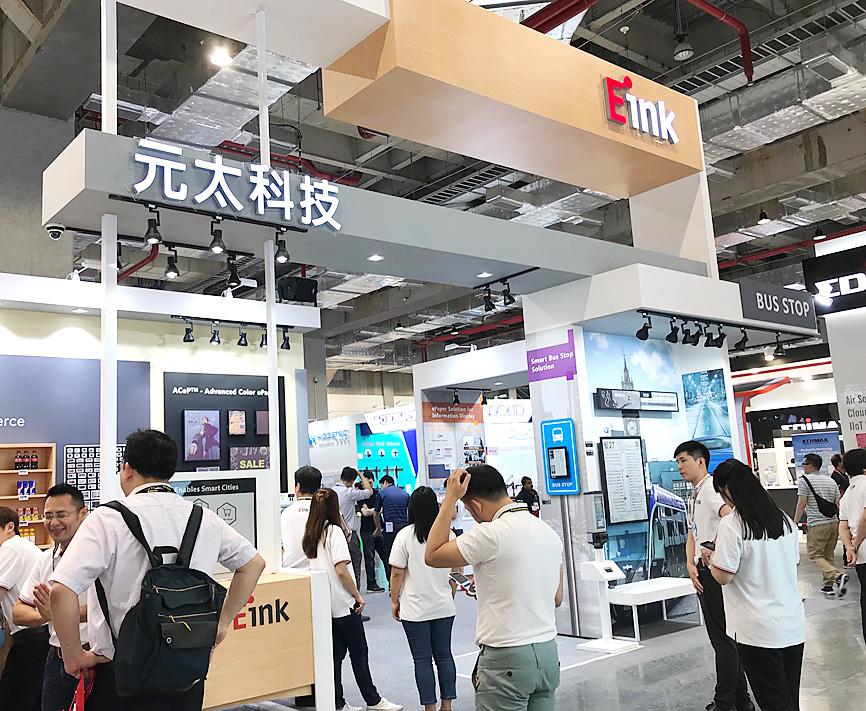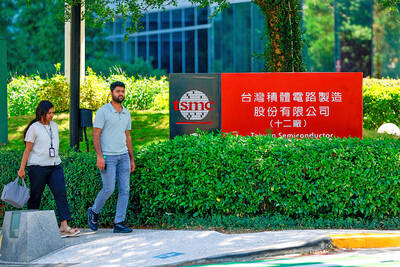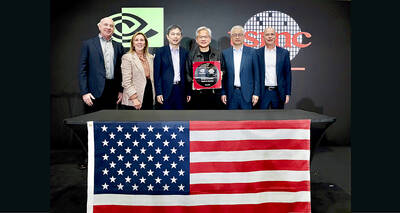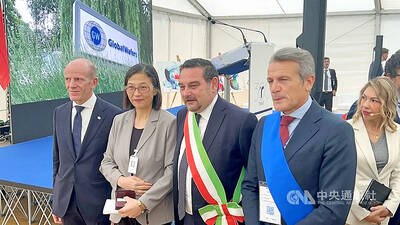E Ink Holdings Inc (元太科技), the world’s biggest e-paper display supplier, yesterday said revenue would continue to grow on an annual basis in the first half of the year, as large-scale retailers such as Walmart Inc are accelerating their adoption of electronic shelf labels (ESLs).
E ink said it is seeing rapidly growing demand for ESLs from hypermarkets in Europe, as retailers are motivated to push for store digitalization due to rising labor costs and a shortage of labor.
“We think higher inflation will boost ESL demand. We are seeing stronger demand and more companies are talking about installing ESLs in stores to cope with workforce reductions. Labor costs go up with inflation,” E Ink chairman Johnson Lee (李政昊) told an online investors’ conference in Taipei.

Photo: Chen Mei-ying, Taipei Times
SES-imagotag, an E Ink customer, earlier this month said that it has partnered with Walmart to digitize store shelves in all of the retailer’s outlets.
The company does not expect high inflation to reduce e-reader sales, Lee said, adding that inflation would likely stimulate sales as reading is a relatively inexpensive leisure activity.
“Demand is stronger than we would have imagined,” Lee said. “Demand is not our concern now. Our challenge is to increase the pace at which we’re expanding capacity.”
Revenue in the first two quarters of this year is expected to be higher than the NT$8.49 billion (US$297.36 million) recorded in the same period last year, E Ink chief financial officer Lloyd Chen (陳樂群) said.
Gross margin is also likely to rise in the January-to-June period, as a shortage of key components, such as chips and LCD displays, improved and they became cheaper, Chen said.
Gross margin stood at 45.58 percent in the first half of last year, company data showed.
To handle robust demand, E Ink said it would double capital expenditure to between NT$5 billion and NT$6 billion this year.
E Ink said it would this year launch four new production lines, which would increase capacity by 1.3 to 1.5 times.
The expansion is constrained by longer-than-expected lead times on equipment, it said.
E Ink said it is also in talks with its module partners to study the feasibility of building module assembly lines outside China, because revenue last month fell 5.42 percent year-on-year as COVID-19 restrictions in China closed its factory and its partners’ factories.
To fund capacity expansion, E Ink said it lowered its cash payout ratio this year to about 71 percent from 85 percent last year.
The company’s board of directors has approved the distribution of a cash dividend of NT$3.2 per common share.
E Ink’s earnings per share jumped about 43 percent to NT$4.53 last year, up from NT$3.18 in 2020.
Net profit for the whole of last year increased to NT$5.15 billion from NT$3.6 billion a year earlier.

RECYCLE: Taiwan would aid manufacturers in refining rare earths from discarded appliances, which would fit the nation’s circular economy goals, minister Kung said Taiwan would work with the US and Japan on a proposed cooperation initiative in response to Beijing’s newly announced rare earth export curbs, Minister of Economic Affairs Kung Ming-hsin (龔明鑫) said yesterday. China last week announced new restrictions requiring companies to obtain export licenses if their products contain more than 0.1 percent of Chinese-origin rare earths by value. US Secretary of the Treasury Scott Bessent on Wednesday responded by saying that Beijing was “unreliable” in its rare earths exports, adding that the US would “neither be commanded, nor controlled” by China, several media outlets reported. Japanese Minister of Finance Katsunobu Kato yesterday also

‘DRAMATIC AND POSITIVE’: AI growth would be better than it previously forecast and would stay robust even if the Chinese market became inaccessible for customers, it said Taiwan Semiconductor Manufacturing Co (TSMC, 台積電) yesterday raised its full-year revenue growth outlook after posting record profit for last quarter, despite growing market concern about an artificial intelligence (AI) bubble. The company said it expects revenue to expand about 35 percent year-on-year, driven mainly by faster-than-expected demand for leading-edge chips for AI applications. The world’s biggest contract chipmaker in July projected that revenue this year would expand about 30 percent in US dollar terms. The company also slightly hiked its capital expenditure for this year to US$40 billion to US$42 billion, compared with US$38 billion to US$42 billion it set previously. “AI demand actually

Jensen Huang (黃仁勳), founder and CEO of US-based artificial intelligence chip designer Nvidia Corp and Taiwan Semiconductor Manufacturing Co (TSMC, 台積電) on Friday celebrated the first Nvidia Blackwell wafer produced on US soil. Huang visited TSMC’s advanced wafer fab in the US state of Arizona and joined the Taiwanese chipmaker’s executives to witness the efforts to “build the infrastructure that powers the world’s AI factories, right here in America,” Nvidia said in a statement. At the event, Huang joined Y.L. Wang (王英郎), vice president of operations at TSMC, in signing their names on the Blackwell wafer to

Taiwan-based GlobalWafers Co., the world’s third largest silicon wafer supplier, on Wednesday opened a 12-inch silicon wafer plant in Novara, northern Italy - the country’s most advanced silicon wafer facility to date. The new plant, coded “Fab300,” was launched by GlobalWafers’ Italian subsidiary MEMC Electronics Materials S.p.A at a ceremony attended by Taiwan’s representative to Italy Vincent Tsai (蔡允中), MEMC President Marco Sciamanna and Novara Mayor Alessandro Canelli. GlobalWafers Chairwoman Doris Hsu (徐秀蘭) said the investment marked a milestone in the company’s expansion in Europe, adding that the Novara plant will be powered entirely by renewable energy - a reflection of its